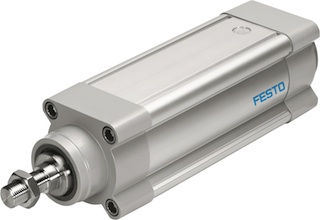An ongoing discussion within the power transmission community is the suitability of different technologies (i.e. pneumatic, hydraulic, electric) for a variety of applications. Conventional wisdom has been that pneumatics are good for low force applications while hydraulics are good where high force is needed, with electric actuators making inroads into once solidly pneumatic or hydraulic areas.
One truism has been that hydraulic actuators have superior power density when compared with pneumatic and electric actuators and so will always have the market cornered for applications needing high force.
Of course, manufacturers have been pushing those limits for years, and a new release pushes those limits even further. A new electric cylinder from Festo moves the line even closer to the limit of the hydraulics-only zone.
Festo’s new ESBF heavy duty electric cylinder is capable of generating almost two tons (17,000 N) of feed force, making it possible to use in place of an hydraulic cylinder. The ESBF extends the range of Festo electric cylinders beyond its DNCE electric cylinder range and provides a significant increase in maximum possible feed forces and speeds. 
The electric cylinder is available in three sizes (63, 80, and 100 mm) with three ball-screw pitches per size, making the ESBF a good fit for a wide range of feed forces and speeds. The ESBF is ideal for dynamic, high-feed-force applications, such as clamping, pressing, cable tensioning, and large component feeding.
With the optional IP65 protection and bellows kit, the ESBF can be customized for a wide range of environments, including high humidity, sawdust, or metal chips, among others.
Other specifications include a maximum stroke length of 1,500 mm, maximum speed of 1.35 m/sec, max acceleration of 25 m/sec2 and repetition accuracy of ±10 μm to ±15 μm.
For more information, visit festo.com/us.
 Read more about off-highway applications (and get more technical white papers and articles) at our sister website —
Read more about off-highway applications (and get more technical white papers and articles) at our sister website —
— www.mobilehydraulictips.com.


Leave a Reply
You must be logged in to post a comment.